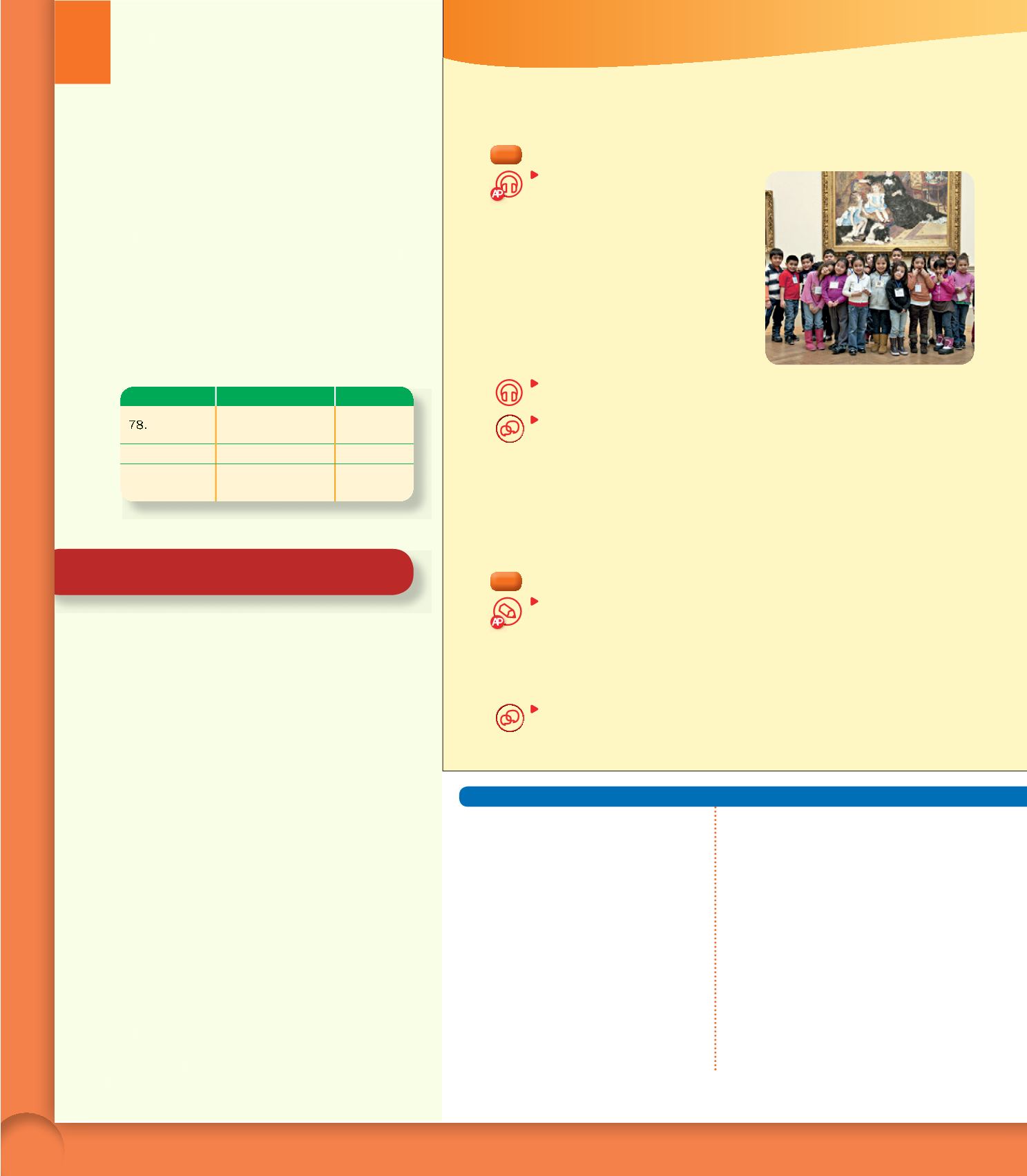

Book 4 Unit 6
108
Differentiated Instruction
DEVELOPING LEARNERS
r
Ask students to match the author or artist to
his or her work.
1.
Orozco
(f)
a.
Los músicos
2.
G. Márquez
(b)
b.
Cien años de
soledad
3.
E. Chillida
(g)
c.
la Sagrada Familia
4.
Gaudí
(c)
d.
Guernica
5.
Borges
(h)
e.
La casa de los
espíritus
6.
I. Allende
(e)
f.
Lucha por la
independencia
7.
D. Rivera
(i)
g.
El peine del viento
8.
Picasso
(d)
h.
El Sur
9.
Botero
(a)
i.
Historia de México
EXPANDING LEARNERS
r
Ask students to think about their favorite
novel or short story; it could be one originally
written in Spanish or in any other language.
Have students consider a scene that they
especially liked and contemplate how they
might change it. Then, have them take into
account their ideas and start rewriting the
scene. When they finish, call on students
to first identify the work and its author and
then give a brief summary of the original
scene. Then ask students to read their
version aloud.
Presentation
.
In this section, students will review the unit
objectives and put them into practice. They
will learn how art is presented to children in a
Spanish museum and will write an e-mail to a
classmate. Students will also select one of the
following
desafíos
to develop: research the most
famous painting by Velázquez
, Las Meninas
,
and compare it to a version by Picasso; select
a famous sculpture or building by a Hispanic
designer and record a presentation for the class;
prepare a presentation about a famous writer
from the Spanish-speaking world.
Activities
Standards
Resources
1.1, 1.2, 1.3, 2.1,
2.2, 3.1, 3.2, 5.2
Audio
79.
1.1, 1.3, 3.1, 5.1
80. Tu desafío
1.3, 2.1, 2.2, 3.1,
3.2, 5.2
Teaching Suggestions
Warm-Up/ Independent Starter
.
Have students go back and review the vocabulary
and grammar sections in this unit.
Preparation
.
Ask students to work on the following individually:
1. write a paragraph comparing two paintings or
two buildings; 2. write four sentences expressing
their opinions about a book they have read
recently; 3. make recommendations to a Spanish-
speaking tourist about places to visit and things
to see in their town.
.
Once students have finished, have them get
together with a partner and check each other’s
work. Tell students that they may use their
textbooks as reference. Answer any questions
students may have about their partner’s work.
.
Have students switch partners and give each new
pair a photo (or show them an online image) of
a famous painting, sculpture, or building. Have
pairs describe their assigned piece in terms of
colors, shapes, materials used, style, etc. Then,
have them share their photos and opinions with
the class.
Todo junto
ESCUCHAR, ESCRIBIR Y HABLAR
7
8
El arte al alcance de los niños
Escucha
un programa cultural y decide si
estas afirmaciones son ciertas o falsas.
Después, corrige las falsas.
1.
El Museo Reina Sofía ofrece visitas
guiadas para los niños en Navidad.
2.
Unos artistas de circo explican las obras
a los niños cantando.
3.
Los niños pueden pisar
(step on)
una
de las obras.
4.
Los niños van a poder interactuar con
varias obras.
5.
Las obras elegidas son fáciles de entender
para todo el mundo.
Escucha
el programa de nuevo y escribe un breve resumen de la entrevista
para el periódico local.
Habla
con tu compañero(a) sobre tu experiencia con el arte. Túrnense para
hacerse estas preguntas.
1.
¿Qué museos y monumentos visitaste durante tu infancia? ¿Con quién fuiste?
2.
¿Qué prefieres: la pintura, la escultura o la arquitectura? ¿Por qué?
3.
¿Qué pintor(a) o escultor(a) te gusta más? ¿Por qué?
4.
¿Tienes alguna reproducción de un(a) artista famoso(a) en tu cuarto? ¿Cómo es?
5.
¿Piensas que el arte es importante? ¿Por qué?
ESCRIBIR, LEER Y HABLAR
7
9
La arquitectura y yo
Escribe
un correo electrónico a tu compañero(a) recomendándole que visite un
edificio famoso que te gusta. Explícale:
– Qué es lo que más te gusta de ese edificio.
– Por qué crees que le va a gustar a él/ella.
– Qué te parece más interesante de su construcción y su diseño.
– Qué le recomiendas que haga cuando lo visite.
Lee
el correo de tu compañero(a) y comparen los edificios que han elegido teniendo
en cuenta estos aspectos: antigüedad, diseño y materiales.
Para terminar
Unit
6
340


















